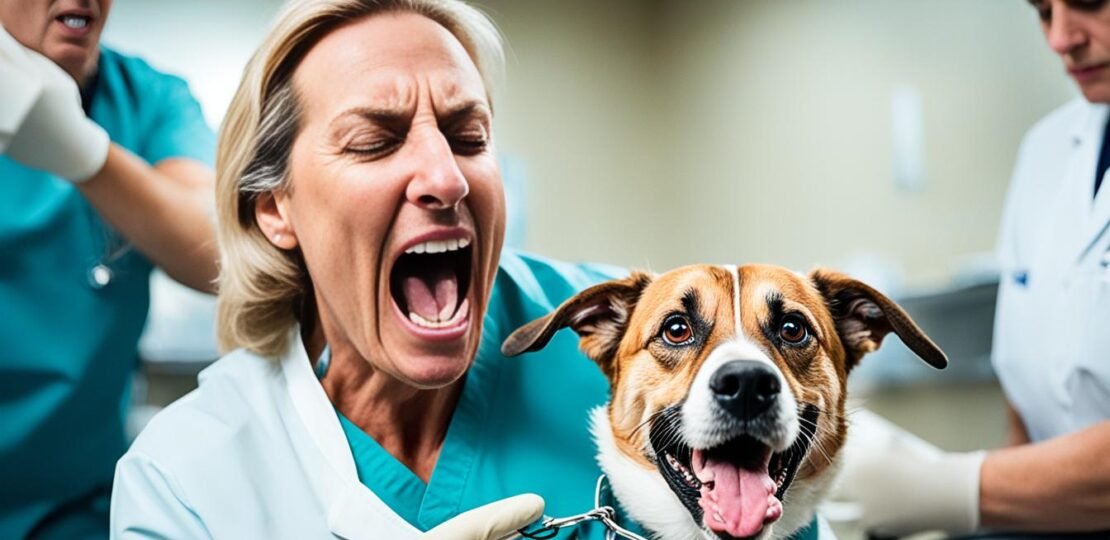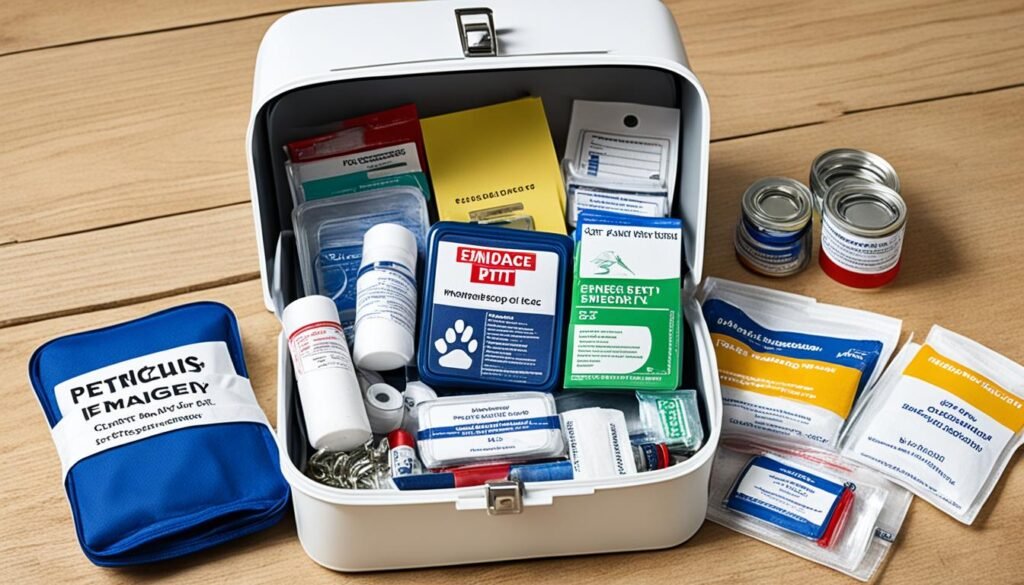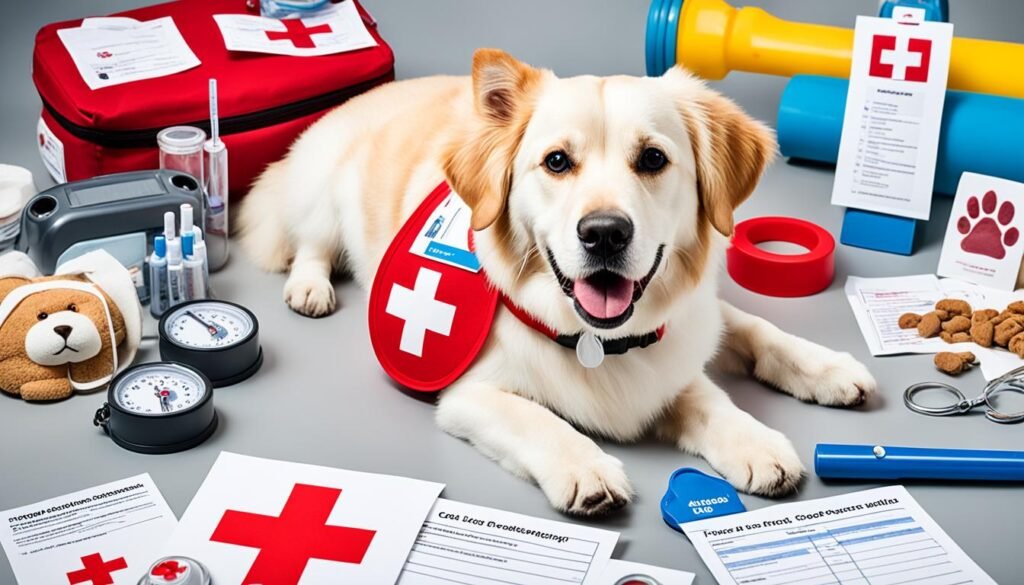
Welcome to our comprehensive guide on handling pet emergencies. As pet owners, it’s essential to be prepared for unexpected situations and know how to respond swiftly and effectively. Whether it’s a minor injury or a more serious health crisis, knowing the basics of emergency vet care and pet first aid can make a significant difference in saving your furry friend’s life.
In this article, we will provide you with valuable tips and information on pet emergencies. You will learn about the different types of emergencies and when immediate veterinary care is necessary. We will also guide you on building an emergency pet kit, equipping you with the necessary supplies during a crisis.
Understanding pet first aid is crucial to stabilize your pet’s condition before professional help arrives. We will share vital first aid techniques, such as performing CPR on pets and controlling bleeding. Recognizing the signs of common pet emergencies, including choking, poisoning, heatstroke, and injuries, will also be discussed.
It’s important to be aware of the resources available when you need help. We will provide information on pet emergency hotlines and additional resources that can assist you in times of crisis. Being prepared with these contact details can save crucial minutes when your pet’s health is at stake.
Throughout this journey, we aim to empower you with the knowledge and tools necessary to handle pet emergencies with confidence. Your furry friend relies on you for their well-being, and by being informed and prepared, you can provide them with the best possible care. So let’s dive in and become pet emergency champions!
Understanding Pet Emergencies
When it comes to the well-being of our beloved furry companions, understanding pet emergencies is of utmost importance. Knowing what constitutes an emergency and when immediate veterinary care is necessary can save your pet’s life. In this section, we will explore different types of emergencies and provide information on animal emergency clinics and 24-hour pet hospitals.
Emergencies can strike at any time, and having access to a reliable animal emergency clinic or 24-hour pet hospital is crucial. These specialized facilities are equipped to handle urgent situations and provide round-the-clock care for your pet.
Animal emergency clinics are staffed with skilled veterinarians and support personnel who are experienced in handling critical cases. They are equipped with advanced medical equipment and resources to provide the necessary care in emergency situations. When every minute counts, these clinics are ready to step in and ensure your pet receives immediate attention.
Similarly, 24-hour pet hospitals offer continuous care throughout the day and night. They have teams of dedicated professionals who are trained to handle emergencies and provide comprehensive medical care for your pet, no matter the time of day.
It’s essential to know the location of the nearest animal emergency clinic or 24-hour pet hospital to ensure prompt access when needed. Keep their contact information readily available in case of an emergency. Remember, quick action and timely medical intervention can make all the difference in saving your pet’s life.
| Animal Emergency Clinic vs. 24-Hour Pet Hospital | Animal Emergency Clinic | 24-Hour Pet Hospital |
|---|---|---|
| Operating Hours | May have extended late-night hours or be available 24/7 | Open 24 hours a day, 7 days a week |
| Staff | Skilled veterinarians and support personnel experienced in handling emergencies | Dedicated teams of professionals trained to handle emergencies |
| Equipment | Equipped with advanced medical equipment for emergency care | Comprehensive range of medical resources available |
| Services | Offers immediate care for various emergency situations | Provides continuous care around the clock |
When faced with a pet emergency, always prioritize your pet’s well-being and seek professional help without delay. The expertise and resources available at animal emergency clinics and 24-hour pet hospitals ensure that your furry friend receives the best possible care when they need it most.
Building an Emergency Pet Kit
When a pet emergency strikes, having a well-equipped pet emergency kit can make all the difference in providing immediate care for your beloved furry friend. It’s crucial to be prepared and have the necessary supplies readily available. Whether you’re at home or on the go, follow our guide below to ensure your emergency pet kit is stocked and ready to use.
Gathering Essential Supplies
Start by assembling the following essential items:
- Food and Water: Pack a sufficient amount of your pet’s regular food and store it in an airtight container. Include a portable water bowl and enough water to last for at least three days.
- Medications: If your pet requires regular medication, include a supply that can last for at least a week. Don’t forget to rotate the medications to ensure they remain fresh and effective.
- First Aid Kit: A well-stocked pet first aid kit is essential for providing initial care during emergencies. Include items such as bandages, gauze pads, adhesive tape, antiseptic wipes, hydrogen peroxide, and a pet-safe thermometer.
- Comfort Items: Pack familiar items that can help keep your pet calm and reduce stress. This may include their favorite toy, blanket, or a piece of clothing with your scent.
- Extra Leash and Collar: Keep an extra leash and collar in your emergency pet kit in case your pet’s regular ones are lost or damaged.
Remember to regularly check and update your emergency pet kit to ensure that all supplies are within their expiration dates and in good condition.
Emergency Pet Services
In addition to your pet emergency kit, it’s essential to be aware of the available emergency pet services in your area. Research and keep a list of emergency veterinary clinics, 24-hour pet hospitals, and contact information for emergency pet hotlines. In times of crisis, these resources can provide crucial guidance and support.
| Emergency Pet Services | Contact Information |
|---|---|
| Local Animal Hospital | 123-456-7890 |
| 24/7 Emergency Clinic | 987-654-3210 |
| Pet Poison Helpline | 800-123-4567 |
Having this information readily available will save you precious time during emergencies when every second counts.
Remember, building an emergency pet kit and familiarizing yourself with emergency pet services are proactive steps that can help ensure the safety and well-being of your furry companion during a crisis.

Pet First Aid Basics
When a pet emergency strikes, knowing basic pet first aid can make a world of difference in stabilizing your furry friend’s condition before professional help arrives. Whether it’s performing CPR or controlling bleeding, having the knowledge and skills to provide immediate care can be lifesaving.
Performing CPR on Pets
Cardiopulmonary resuscitation (CPR) can help restart your pet’s heart and restore breathing in critical situations. It’s crucial to approach CPR with caution and follow these steps:
- Check for responsiveness: Gently tap your pet and call their name. If they are unresponsive, proceed with CPR.
- Clear the airway: Open your pet’s mouth and remove any obstructions that may hinder breathing.
- Begin chest compressions: Adjust the pressure based on the size of your pet. For larger animals, use both hands to compress the chest, while smaller pets may require just a single hand.
- Perform rescue breaths: Close your pet’s mouth and breathe into their nose until you see the chest rise. Repeat the process every three to four seconds.
- Continue CPR: Alternate between chest compressions and rescue breaths until your pet starts breathing on their own or professional help arrives.
Remember, CPR is a temporary measure and should always be followed by immediate veterinary care.
Controlling Bleeding
When your pet is bleeding, taking quick action is crucial to minimize blood loss and prevent further complications. Follow these steps to control bleeding:
- Apply direct pressure: Using a clean cloth or gauze, apply firm pressure directly to the wound to stem the bleeding.
- Elevate the injured area: If possible, raise the wounded area above the heart level to help reduce blood flow.
- Apply a pressure bandage: Wrap a bandage firmly but not too tight around the wound, ensuring it stays in place.
- Seek immediate veterinary care: Even if you manage to control the bleeding, it’s essential to have a veterinarian assess and treat the wound to prevent infection and promote proper healing.
Remember, these techniques are just a starting point, and it’s crucial to consult with a veterinarian for comprehensive guidance on pet first aid.

| Common Pet First Aid Techniques | Description |
|---|---|
| CPR | Cardiopulmonary resuscitation to revive pets in critical situations. |
| Controlling Bleeding | Methods to minimize blood loss and prevent further complications. |
| Administering Medications | Proper techniques for safely providing prescribed medications to pets. |
| Heimlich Maneuver | A technique to dislodge objects stuck in a pet’s throat to prevent choking. |
Recognizing Common Pet Emergencies
When it comes to our furry companions, emergencies can happen unexpectedly. Knowing how to spot the signs and symptoms of common pet emergencies can help you act swiftly and seek the right care for your beloved pet. In this section, we will cover some of the most frequent emergencies faced by pets and guide you on when immediate emergency vet care is necessary.
Choking:
Pets, especially curious ones, may accidentally swallow objects that can obstruct their airways. Common signs of choking include:
- Difficulty breathing
- Pawing at the mouth
- Gagging or retching
- Blue or pale gums
If your pet is choking, it is essential to act quickly.
Wrap your arms around your pet’s body, making a fist just behind the ribcage. Apply firm but gentle pressure, pushing in and up several times to dislodge the object. If your pet is too big to pick up or the choking object doesn’t come out, rush to the nearest emergency vet clinic.
Poisoning:
Accidental ingestion of toxic substances can lead to poisoning in pets. Common signs of poisoning include:
- Vomiting or diarrhea
- Lethargy or weakness
- Loss of appetite
- Seizures
- Excessive drooling
If you suspect your pet has ingested something toxic, contact your veterinarian or a pet poison control hotline immediately.
Heatstroke:
Pets are susceptible to heatstroke, especially in hot and humid climates. Signs of heatstroke include:
- Excessive panting
- Difficulty breathing
- Dark or bright red gums
- Vomiting
Heatstroke can be life-threatening, requiring immediate intervention. Move your pet to a cool, shaded area and apply cool water to their body while seeking emergency vet care.
Injuries:
Accidents and injuries can occur at any time, especially in active pets. Common signs of injuries include:
- Bleeding
- Lameness or difficulty walking
- Visible wounds or fractures
- Unusual swelling
For serious injuries, it’s crucial to contact an emergency vet clinic right away.
Remember, recognizing these common pet emergencies is the first step in ensuring prompt and appropriate care for your pet. With swift action and proper emergency vet care, you can increase the chances of a positive outcome for your furry friend.

Pet Emergency Hotline and Resources
In moments of crisis, knowing who to contact can make all the difference in getting swift help for your beloved pet. Having access to a reliable pet emergency hotline is crucial for timely assistance. In times when every second counts towards saving your pet’s life, a pet emergency hotline can provide you with the guidance and support you need.
When you find yourself in the midst of a pet emergency, the pet emergency hotline connects you with trained professionals who can offer advice and direct you to appropriate veterinary care. The hotline staff can provide instructions to stabilize your pet’s condition before you can reach a veterinarian or an animal emergency clinic.
Keep the contact information for the pet emergency hotline readily available in your emergency pet kit, alongside essential supplies. Furthermore, familiarize yourself with local animal welfare organizations, such as animal control services or veterinary associations, as they often provide additional resources and support during emergencies.
Remember, being prepared and having the pet emergency hotline on hand can help you remain calm and take immediate action during a pet emergency. With the support and guidance offered by these resources, you can provide your pet with the best chances of a successful recovery.
FAQ
Can I administer first aid to my pet in case of an emergency?
How do I know if it’s a pet emergency that requires immediate veterinary care?
What should I include in my emergency pet kit?
How can I perform CPR on my pet if needed?
What are some signs of common pet emergencies?
Is there a pet emergency hotline I can call?
RELATED POSTS
View all


